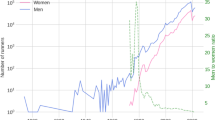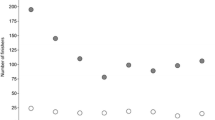Abstract
Background
Currently no studies have examined the historical performances of Oxford and Cambridge Boat Race crews in the context of performance, pacing and tactics which is surprising as the event has routinely taken place annually for over 150 years on the same course.
Objectives
The purpose of this study was twofold, to firstly examine the historical development of performances and physical characteristics of crews over 124 years of the Oxford and Cambridge Boat Race between 1890 and 2014 and secondly to investigate the pacing and tactics employed by crews over that period.
Methods
Linear regression modelling was applied to investigate the development of performance and body size for crews of eight male individuals over time from Boat Race archive data. Performance change over time was further assessed in 10-year clusters while four intra-race checkpoints were used to examine pacing and tactics.
Results
Significant correlations were observed between performance and time (1890–2014) for both Oxford (r = −0.67; p < 0.01) and Cambridge (r = −0.64; p < 0.01). There was no difference in mean performance times for Oxford (1170 ± 88 s) and Cambridge (1168 ± 89.8 s) during 1890–2014. Crew performance times improved over time with significant gains from baseline achieved in the 1950s (Cambridge) and the 1960s (Oxford), which coincided with significant change in the physicality of the competing crews (p < 0.01). There was no tactical advantage from commencing on either the Surrey or Middlesex station beyond chance alone; however, all crews (n = 228) adopted a fast-start strategy, with 81 % of victories achieved by the crew leading the race at the first intra-race checkpoint (24 % of total distance). Crews leading the race at the final checkpoint (83 % of total distance; 1143 m) achieved victory on 94 % of occasions.
Conclusion
Performances and physical characteristics of the crews have changed markedly since 1890, with faster heavier crews now common. Tactically, gaining the early lead position with a fast-start strategy seems particularly meaningful to success in the Boat Race throughout the years, and has been of greater importance to race outcome than factors such as the starting station.




Similar content being viewed by others
References
Desgorces FD, Berthelot G, El Helou N, et al. From Oxford to Hawaii ecophysiological barriers limit human progression in ten sport monuments. PLoS One. 2008;3:e3653.
Ross G. The Boat Race: the story of the first hundred races between Oxford and Cambridge. London: Sportsmans Book Club; 1956. p. 1–256.
Dodd C, Marks J, Clegg D, et al. Battle of the Blues: the Oxford and Cambridge Boat Race from 1829. London: P to M Ltd; 2004. p. 1–108.
Bishop D, Bonetti D, Dawson B. The influence of pacing strategy on VO2 and supramaximal kayak performance. Med Sci Sport Exerc. 2002;34:1041–7.
Atkinson G, Peacock O, St Clair Gibson A, et al. Distribution of power output during cycling: impact and mechanisms. Sports Med. 2007;37:647–67.
Edwards AM, Polman RCJ. Pacing and awareness: brain regulation of physical activity. Sports Med. 2013;43:1057–64.
De Campos Mello F, De Moraes Bertuzzi RC, Grangeiro PM, et al. Energy systems contributions in 2000 m race simulation: a comparison among rowing ergometers and water. Eur J Appl Physiol. 2000;2009(107):615–9.
Hofmijster MJ, Landman EH, Smith RM, et al. Effect of stroke rate on the distribution of net mechanical power in rowing. J Sports Sci. 2007;25:403–11.
Mäestu J, Jürimäe T. Monitoring of performance and training in rowing. Sports Med. 2005;35:597–617.
Abbiss CR, Laursen PB. Describing and understanding pacing strategies during athletic competition. Sports Med. 2008;38:239–52.
de Koning JJ, Bobbert M, Foster C. Determination of optimal pacing strategy in track cycling with an energy flow model. J Sci Med Sport. 1999;2:266–77.
Hettinga FJ, de Koning JJ, Schmidt LJI, et al. Optimal pacing strategy: from theoretical modelling to reality in 1500-m speed skating. Br J Sports Med. 2011;45:30–5.
Smits B, Pepping GJ, Hettinga FJ. Pacing and decision-making in sport and exercise: on the roles of perception and action in the regulation of exercise intensity. Sports Med. 2014;44:763–75.
Edwards AM, Lander PJ. Physiological responses to self-paced exercise: effort matched comparisons across running and rowing modalities. J Sports Med Phys Fit. 2012;52:344–50.
Konings M, Noorbergen O, Parry D, et al. Pacing in a broader sense: tactical positioning in 1500 m short track speed skating. Int J Sports Physiol Perform. 2016;11:122–9.
Noorbergen O, Konings M, Micklewright D, et al. Pacing in a broader sense: tactical positioning in 500 and 1000 m short track speed skating. Int J Sports Physiol Perform. 2016. doi:10.1123/ijspp.2015-0384.
Brown MR, Delau S, Desgorces FD. Effort regulation in rowing races depends on performance level and exercise mode. J Sci Med Sport. 2010;13:613–7.
Garland SW. An analysis of the pacing strategy adopted by elite competitors in 2000 m rowing. Br J Sports Med. 2005;39:39–42.
Muehlbauer T, Schindler C, Widmer A. Pacing pattern and performance during the 2008 Olympic rowing regatta. Eur J Sport Sci. 2010;10:291–6.
Muehlbauer T, Melges T. Pacing patterns in competitive rowing adopted in different race categories. J Strength Cond Res. 2011;25:1293–8.
Boat Race Ltd. The Boat Race origins. http://www.theboatraces.org. Accessed 2 Feb 2015.
Gilbert G, Marks J. Battle of the Blues: the Oxford and Cambridge Boat Race from 1829. London: P to M Ltd; 2004. p. 1–108.
van Ingen Schenau GJ, Cavanagh PR. Power equations in endurance sports. J Biomech. 1990;23:865–81.
Morgan JE. University oars: being a critical enquiry into the after health of the men who rowed in the Oxford and Cambridge boat-race from the year 1829–1869, based on the personal experience of the rowers themselves. London: Macmillan; 1873.
Desgorces FD, Chennaoui M, Guezennec CY. Influence of anthropometrics parameters on rowing performance at national level. Sci Sports. 2004;19:327–9.
Fiskerstrand A, Seiler KS. Training and performance characteristics among Norwegian International Rowers 1970–2001. Scand J Med Sci Sports. 2004;14:303–10.
Hathaway ML. Trends in heights and weights. The yearbook of agriculture. Washington DC: The United States Government Printing Office; 1959. p. 53–8.
Secher NH. Physiological and biomechanical aspects of rowing. Sports Med. 1993;15:24–42.
Stoter IK, MacIntosh BR, Fletcher JR, et al. Pacing strategy, muscle fatigue and technique in 1500 m speed skating and cycling. Int J Sports Physiol Perform. 2016. doi:10.1123/ijspp.2014-0603.
Noakes TD. Time to move beyond a brainless exercise physiology: the evidence for complex regulation of human exercise performance. Appl Physiol Nutr Metab. 2011;36:23–35.
Lander PJ, Butterly RJ, Edwards AM. Self-paced exercise is less physically challenging than enforced constant pace exercise of the same intensity: influence of complex central metabolic. Br J Sports Med. 2009;43:789–95.
Konings M, Schoenmakers P, Walker A, et al. The behavior of an opponent alters pacing decisions in 4-km cycling time trials. Physiol Behav. 2016;158:1–5.
Acknowledgments
The authors acknowledge the support of Boat Race Ltd and the Boat Race archivist in the preparation of this manuscript. Data were retrieved from previously published public databases with the support of Boat Race Ltd and did not contain personal information.
Author information
Authors and Affiliations
Corresponding author
Ethics declarations
Funding
No sources of funding were sought or used to assist in the preparation of this article.
Conflicts of interest
Andrew Edwards, Joshua Guy and Florentina Hettinga declare that they have no conflicts of interest relevant to the content of this review.
Ethical considerations
Data were retrieved from previously published public databases with the support of the Boat Race Ltd and did not contain personal information. Because this analysis relies exclusively on publicly available data, it is exempt from institutional review board requirements.
Rights and permissions
About this article
Cite this article
Edwards, A.M., Guy, J.H. & Hettinga, F.J. Oxford and Cambridge Boat Race: Performance, Pacing and Tactics Between 1890 and 2014. Sports Med 46, 1553–1562 (2016). https://doi.org/10.1007/s40279-016-0524-y
Published:
Issue Date:
DOI: https://doi.org/10.1007/s40279-016-0524-y




